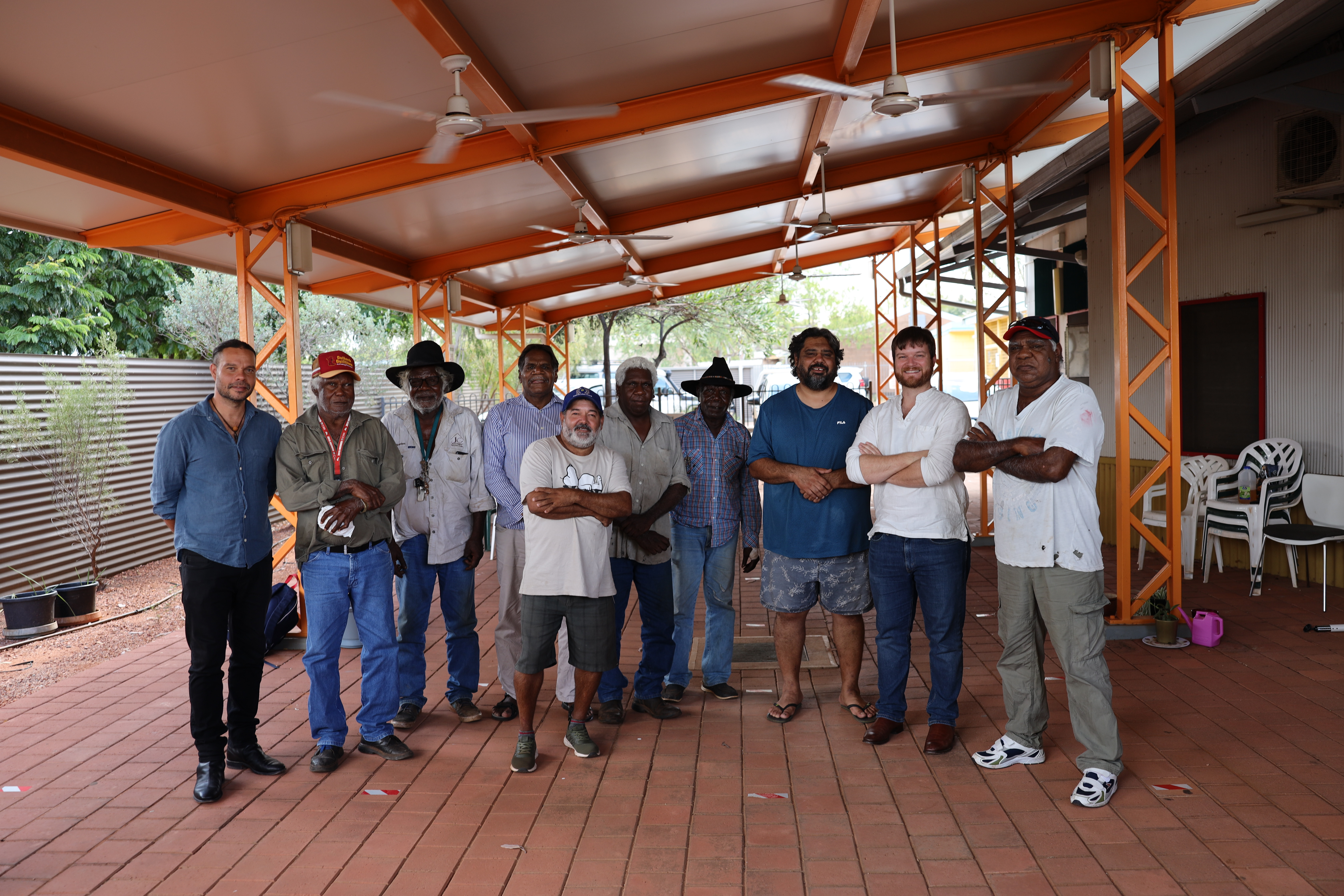After an absence of over a century six Warumungu objects will return to Australia following discussions between AIATSIS, the Warumungu community of the Tennant Creek region and the Tūhura Otago Museum in Dunedin in New Zealand.
The collection includes a kalpunta (boomerang), palya/kupija (adze) and a selection of marttan (stone knife).
The provenance trail for these objects is long. They were originally collected sometime around the late 19th or early 20th century by James Field, the telegraph station master in Tennant Creek, and Walter Baldwin Spencer, the well-known British-born anthropologist.

Senior Warumungu men and AIATSIS staff following a community engagement meeting about the objects, Tennant Creek, March 2020. Photo: Andrews Fahey, CLC.
Senior Warumungu men and AIATSIS staff following a community engagement meeting about the objects, Tennant Creek, March 2020. Photo: Andrews Fahey, CLC.
The Tūhura Otago Museum acquired the objects through exchanges with Museum Victoria in 1923 and 1937 and an exchange with Frederick Vincent Knapp, a well-known amateur archaeologist and ethnologist, in 1910.
The return of these six Warumungu objects results from ongoing work by the AIATSIS Return of Cultural heritage (RoCH) team in identifying cultural materials held in collections outside of Australia and then initiating discussion on their return.
In September 2021, the RoCH team facilitated a virtual meeting with senior Warumungu men, staff of the Tūhura Otago Museum, and members of the museum’s Māori Advisory Committee to discuss the significance of these objects. In June 2022 the museum’s Trust Board endorsed a repatriation request and research report summitted by AIATSIS and the Warumungu men, the result of two years of consultation and research.
Senior Warumungu man, Mr Michael Jones, expressed his community’s appreciation for the museum’s response.
‘Them old things they were carved by the old people who had the songs for it, too. I’m glad these things are returning back,’ Mr Jones said. ‘The museums are respecting us, and they’ve been thinking about us. They weren’t the ones who took them, they just ended up there. We can still teach the young people now about these old things and our culture.’
The Minister for Indigenous Australians, the Hon Linda Burney MP, welcomed the museum’s response.
‘The return of cultural heritage material after more than a century is a significant moment for the Warumungu people and fundamental to the processes of truth-telling and reconciliation,’ Minister Burney said. ‘Repatriations like these are critical for the transfer of knowledge and cultural maintenance and revitalisation for future generations.
‘I commend the team at AIATSIS for the work undertaken with the Tūhura Otago Museum to negotiate the unconditional return of this material. I would also like to extend my heartfelt gratitude to the museum for the good-faith return of these items – a move that recognises the importance of cultural heritage to identity.’
Craig Ritchie, AIATSIS CEO, said that one of the key achievements of the RoCH program is in giving voice to the originating communities in how their heritage is managed by collecting institutions outside of Australia.
‘Storytelling is integral to the transmission of our cultural knowledge,’ Mr Ritchie said. ‘Objects created in our communities, both sacred and secular, bear evidence of the skills of those who created them along with evidence of our cultural values. We don’t want to lose track of such storytelling aids, and our communities want a say in how they are used.
‘AIATSIS is grateful to the Tūhura Otago Museum Māori Advisory Committee, the museum Trust Board, and the museum staff for the very positive manner in which they have conducted a dialogue on this return with the Warumungu representatives and with AIATSIS.
‘Our thanks also to Kāi Tahu, the local Māori tribe who, through the Māori Advisory Committee, have helped ensure the care and respect for these objects while they remained on their homelands.’
Since 1868, the Tūhura Otago Museum has accumulated one of the finest and most diverse collections of taoka (treasures) in Aotearoa New Zealand.
‘More than just material expressions of a culture, these taoka are also tangible links to the ancestors who made them so they must be treated with the greatest of care and respect,’ said Robert Morris, Director of Collections, Research and Education at the museum.
In recent years, supported by the Māori Advisory Committee, the museum’s Trust Board has embedded its support for the cultural property clauses of the United Nations Declaration on the Rights of Indigenous Peoples which calls for providing access to and repatriation of ceremonial objects and ancestral remains where appropriate.
‘This recognises that returning these treasures to country is part of ensuring their culturally appropriate care and seeing their story in the community reinvigorated,’ Mr Morris said. ‘The Tūhura Otago Museum is looking forward to welcoming the Warumungu people and the RoCH team to Dunedin for the hand over once safe travel arrangements can be made.’
Warumungu people are the traditional custodians of land in and around the township of Tennant Creek, Northern Territory. In March 2021 the AIATSIS RoCH team began consultations with senior Warumungu men regarding cultural materials held in New Zealand. The RoCH team plans to travel to New Zealand later this year with a delegation of Warumungu representatives to collect these materials. Those representatives will participate in hand-over ceremonies and other protocols with local Māori communities.
The Warumungu community has indicated that a selection of these returned objects will be displayed at the Nyinkka Nyunyu Art and Culture Centre in Tennant Creek.
AIATSIS media enquiries
commsmedia@aiatsis.gov.au
+61 476 843 522
